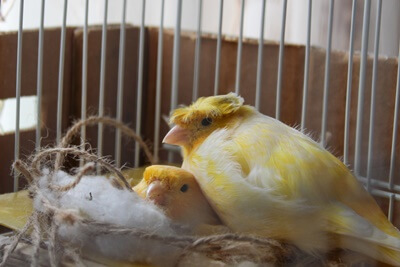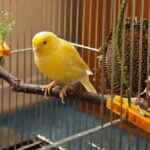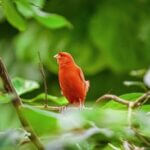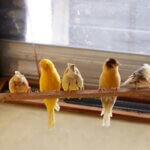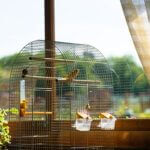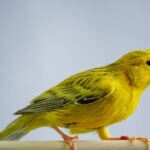Canaries don’t need nesting material; they’re happy to stand on their perches and sleep while sitting down. They need a cozy, safe place to lay their eggs if you intend to breed canaries.
When setting up the nest, you must consider the nest structure and material. The most commonly used materials are sticks, bamboo, plastic, and metal.
Also, you need to consider the nesting material. Most canary breeders use cotton or felt, but other options may be more suitable. Canaries prefer certain types of nesting materials over others.
The more comfortable your female canary is in her nest, the better she’ll care for her young.
What Do Canaries Use For Nesting?
Wild canaries build their nests from readily available materials in their environment, including:
- Swamp grass
- Dry leaves
- Twigs
They’ll build the foundation of their nest before weaving in other materials for padding and insulation. This gives their eggs (and hatchlings) the best chance of developing properly and remaining safe.
However, if you keep canaries in an aviary, they may not have the freedom to forage for nesting materials on their own. So, you’ll need to provide them with a nesting pan and material so they can build their nests indoors in preparation for breeding.
According to Animal Behaviour, domestic canaries deprived of nesting materials during the breeding season experience a delay in egg-laying.
So, it’s important to ensure your pet canaries have everything they need before they start mating, as this will ensure their breeding cycle isn’t interrupted.
Nesting Pans
A nesting pan works as the base foundation for your canary’s nest.
In the wild, canaries would build this by themselves, but you can purchase or make your own to save your canary time. Also, this ensures you have a simpler method of cleaning out the nest.
After all, your canary isn’t able to fly to a new tree and try again if the last one becomes uninhabitable due to feces and food scraps.
The most common commercial types of nesting pans are made from the following:
- Sticks
- Bamboo
- Plastic
- Metal
Canaries prefer stick and bamboo nesting pans because they mimic the natural materials used in the wild. However, the downside to these nests is that they can be harder to clean and aren’t durable.
Plastic and metal nesting pans aren’t aesthetically pleasing to canaries. However, they’re long-lasting and easier to clean. Remember, breeding canaries require a high level of hygiene.
For this reason, choosing a metal or plastic variety is sensible.
Lining Materials
Wild canaries rarely use nest liners, but it’s recommended that you do when keeping canaries at home. Most birds raised in captivity can’t find quality nests without such materials.
Consequently, providing nest lining makes it easier for captive-bred canaries to build areas that can support their eggs without breaking them.
The best nest lining materials for canaries include:
- Felt
- Cotton
If you don’t have these materials, you can opt for other, easily accessible alternatives, such as:
- Soft pieces of cloth
- Unscented bathroom tissue
- Gunny sack fibers
- Thick cotton strings
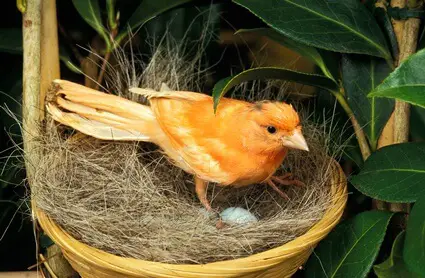
What Do Canaries Need To Make A Nest?
According to the Journal of Zoology, male and female canaries participate in nest building, although the former plays a very small role. So, the task of nest building is mostly delegated to the females.
As an owner, it’s critical to provide the right kind of nesting pan and nesting material. This will ensure your female doesn’t become frustrated by a lack of materials and doesn’t exhaust herself when she should be preparing to lay eggs.
If you can’t find classic nesting materials and pans, you can look for simple alternatives. The key to the creation of a quality nest that’s:
- Stable
- Insulated
- Padded
- Not prone to shifting or moving
- Able to contain several eggs at the center
- It contains loose materials for the female to rearrange and weave, making her nest comfortable.
Regardless of the nesting pan and its materials, you must ensure that it’s set up correctly inside your canary’s cage. Ideally, you should attach the nest to the bars so it hangs a few inches above the ground.
Ensure the nest isn’t directly under your canary’s perch or a feeding bowl, as this might cause it to become soiled by droppings or food.
Likewise, ensure your canary’s nest isn’t so high that it can’t be easily accessed. As a rule of thumb, the top of your canary’s nest should be a minimum of 4 inches from the top of its cage.
Keeping your canary’s nest at this distance will provide enough room to maneuver its way in and out of the nest while also giving it enough space to stand and move around.
Homemade Nesting Materials For Canaries
Nesting materials for canaries can be sourced from pet stores and online. However, the best material could be what’s readily available in your home.
Examples of homemade lining materials include:
- Shredded tissue paper
- Hay
- Small balls of cotton wool
- Pieces of old clothes (rags)
- Strips of newspaper
Shredded tissue paper should be unscented since strong scents irritate the respiratory system.
No matter the type of nesting material you use, ensure that the strands are short so your canary’s feet don’t get tangled up in them.
They should also be easy to maneuver, so your canary can rearrange them. Even an experienced owner may not perfectly customize the nest to their canary’s taste, so leave scope for modification.
What Should I Use For My Canary’s Nest Liner?
Cotton and felt are the most popular liner materials for canary nests.
Aside from being soft and comfortable, these materials aren’t stringy, so there’s less risk of a canary’s feet getting tangled up.
However, you don’t have to restrict yourself to these two materials.
If you have unscented tissue paper in your home, you can shred some of it and use it as a nest liner for your canary’s nest. Alternatively, you can use pieces of old clothes that you no longer use.
Just ensure they’re clean, soft, and light enough for your canary to handle.

